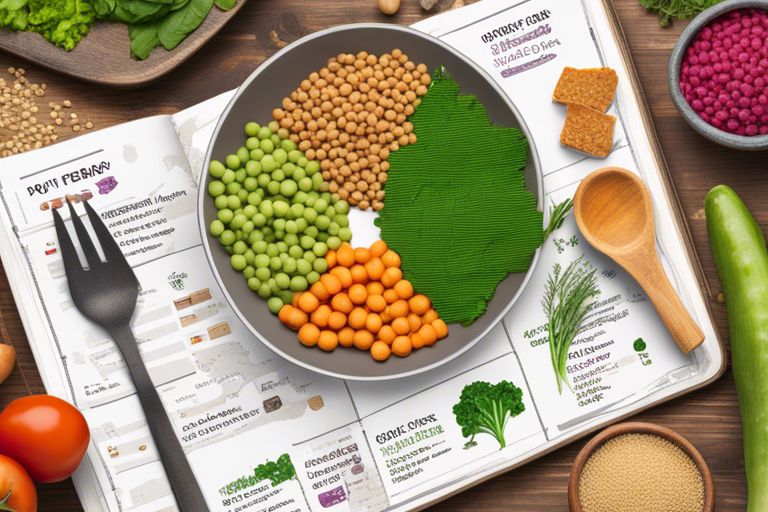Greetings, health-conscious reader! Are you a vegan looking for ways to ensure you get enough protein in your diet? Look no further, as I will guide you through a variety of nutritious and delicious sources of protein that you can incorporate into your meals. From plant-based staples like beans and lentils to lesser-known sources such as quinoa and tofu, there are numerous options available to help you meet your protein needs without compromising on taste or nutritional value.
Plant-Based Protein Sources
By incorporating plant-based protein sources into your diet, you can easily meet your protein requirements. These sources are not only rich in protein but also contain essential nutrients and are low in saturated fat.
Legumes: Beans and Lentils
Legumes, such as beans and lentils, are an excellent source of protein for vegans. They are also high in fiber, which can help you feel full and satisfied after a meal. Additionally, they are packed with essential nutrients such as iron, folate, and potassium. Including a variety of beans and lentils in your diet can help you meet your protein needs while also reaping the benefits of their nutrient-dense profile.
Whole Grains and Cereals
Whole grains and cereals, such as quinoa, oats, and brown rice, are another great source of protein for vegans. They also provide a good amount of fiber, vitamins, and minerals. By incorporating a variety of whole grains and cereals into your diet, you can ensure that you are getting adequate protein as well as essential nutrients to support your overall health.
By including these plant-based protein sources in your diet, you can meet your protein requirements while also enjoying a variety of delicious and nutritious foods. Whether you are a vegan or simply looking to incorporate more plant-based meals into your diet, these protein sources can help you maintain a healthy and balanced eating pattern.
Nuts and Seeds
Some common sources of vegan protein include nuts and seeds. They are packed with protein, healthy fats, and various essential nutrients, making them an excellent addition to a plant-based diet.
Nutritional Benefits of Nuts and Seeds
Nuts and seeds are rich in protein, healthy fats, fiber, vitamins, and minerals. They are particularly high in omega-3 fatty acids, which are essential for heart and brain health. Additionally, they contain antioxidants such as vitamin E and selenium, which can help protect your cells from damage.
Incorporating Nuts and Seeds into Meals
Adding nuts and seeds to your meals is an easy way to boost your protein intake. You can sprinkle them on top of salads, yogurt, or oatmeal, or use them as a base for homemade energy bars and protein balls. You can also use nut butters as a spread or dip for fruits and vegetables. By incorporating nuts and seeds into your meals, you can create delicious and nutritious plant-based dishes.

Soy Products
After discussing legumes, it’s crucial to highlight the importance of soy products as a significant source of vegan protein. Soybeans are a complete protein, containing all essential amino acids that your body needs, making them an excellent addition to your diet. There is a wide variety of soy-based foods available, and they can be easily incorporated into your meals to increase your protein intake.
Varieties of Soy-Based Foods
There are several varieties of soy-based foods that you can include in your diet to ensure that you are getting enough protein. Tofu, tempeh, edamame, and soy milk are some popular options. Tofu is a versatile ingredient that can be used in various dishes, while tempeh has a nutty flavor and firm texture, making it a great meat substitute. Edamame, which are young soybeans, can be enjoyed as a snack or added to salads and stir-fries. Soy milk can be used as a dairy alternative, and it’s an easy way to boost your protein intake.
Preparing Soy for Maximum Nutrition
When incorporating soy products into your diet, it’s essential to prepare them in a way that maximizes their nutritional benefits. It is important to note that soy products contain compounds called anti-nutrients, such as phytates and trypsin inhibitors, which can interfere with the absorption of certain nutrients and digestion. To reduce the levels of these compounds, you can soak, ferment, or cook soybeans and soy-based products. This allows for better digestion and absorption of nutrients, ensuring that you are getting the most out of the protein and other essential nutrients that soy products provide.
By incorporating a variety of soy-based foods into your diet and preparing them in a way that maximizes their nutritional benefits, you can ensure that you are getting an adequate amount of protein as part of your vegan diet. With the plethora of options available, you can easily meet your protein needs while enjoying delicious and nutritious meals.
Other Vegan Protein Alternatives
Despite the popular sources of vegan protein like legumes, nuts, and seeds, there are several other options available to meet your dietary protein needs. Whether you’re looking to switch things up or expand your protein sources, exploring these alternatives can be a great way to add variety to your meals while ensuring you’re getting the protein your body needs.
Plant-Based Meat Substitutes
If you’re looking for a convenient and familiar way to add more protein to your diet, consider incorporating plant-based meat substitutes into your meals. Products made from tempeh, tofu, seitan, or textured vegetable protein can be a tasty and versatile addition to your favorite dishes. These alternatives not only provide a good amount of protein but also offer a meat-like texture and flavor that can satisfy your cravings. Just be sure to check the ingredients, as some processed plant-based meat substitutes may contain a high amount of sodium and preservatives.
Green Vegetables and Seaweed
While you may not immediately think of green vegetables and seaweed as significant sources of protein, they can actually contribute to your daily protein intake. Vegetables such as spinach, broccoli, kale, and Brussels sprouts contain a surprising amount of protein, along with essential vitamins and minerals. Additionally, seaweed varieties like spirulina and chlorella are nutrient-dense and can provide a significant amount of protein. Incorporating these greens into your meals can not only boost your protein intake but also provide you with a range of health benefits.
Combining Food Sources for Complete Protein
Now that you understand the importance of consuming complete proteins as a vegan, it’s time to look at how you can combine different plant-based food sources to ensure you get all the essential amino acids your body needs. By combining complementary proteins, you can create a complete protein that provides all the amino acids required for optimal health.
Understanding Amino Acid Profiles
When it comes to plant-based protein sources, it’s essential to understand the amino acid profiles of different foods. While some plant foods are low in certain essential amino acids, others are rich in those same amino acids. By combining these foods, you can create a complete protein with a balanced profile of all the essential amino acids your body needs. For example, legumes are typically low in methionine but high in lysine, while grains are the opposite. By pairing legumes with grains, you can create a complete protein source that provides all essential amino acids.
Strategies for Complementary Protein Pairing
When it comes to combining plant-based protein sources, there are various strategies you can use to ensure you get a complete protein in your diet. One simple approach is to pair legumes, such as beans, lentils, or chickpeas, with grains like rice, quinoa, or wheat. Another strategy is to combine nuts or seeds with legumes or grains. By incorporating a variety of plant-based protein sources into your meals, you can easily meet your protein needs without relying on animal products.
Overall, understanding the amino acid profiles of different plant-based foods and employing effective strategies for complementary protein pairing can ensure that you get all the essential amino acids your body needs as a vegan. By paying attention to the protein content of the foods you eat and making intentional choices to combine different sources, you can easily meet your protein requirements and maintain a healthy, balanced diet. Remember to experiment with different combinations to find the ones that work best for you and consult a nutritionist or dietitian if you have any concerns about meeting your protein needs on a vegan diet.
Conclusion
Considering all points, you now have a diverse array of plant-based protein sources at your disposal. Whether it’s lentils, chickpeas, tofu, tempeh, quinoa, or a combination of these, there are plenty of options to meet your protein needs on a vegan diet. By incorporating a variety of these sources into your meals, you can ensure that you are getting all the essential amino acids and nutrients necessary for optimal health and well-being. Enjoy exploring different plant-based protein options and discovering new and delicious ways to incorporate them into your diet!


Pingback: The Best Vegan Protein Sources For Muscle Building - Veganism